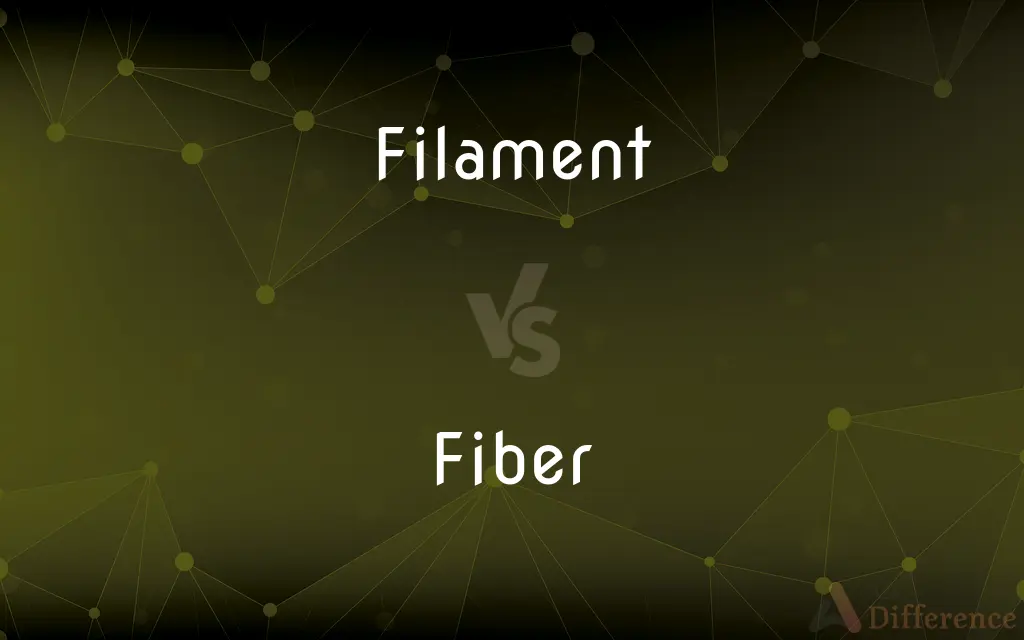Filament vs. Fiber — What's the Difference?
Edited by Tayyaba Rehman — By Maham Liaqat — Updated on March 8, 2024
Filament refers to a continuous thread of material, often used in textiles and manufacturing, while fiber denotes natural or synthetic strands used for weaving or knitting.

Difference Between Filament and Fiber
Table of Contents
ADVERTISEMENT
Key Differences
Filaments are long, continuous threads of material, typically used in the production of textiles, 3D printing, and various industrial applications. These can be natural, like silk, or synthetic, such as polyester. On the other hand, fibers are shorter, natural or synthetic strands that can be spun into yarn or thread for weaving, knitting, or fabric production. Fibers include materials like cotton, wool, and nylon.
One key difference lies in their form and application: filaments are valued for their continuous length, making them ideal for smooth, strong materials. In contrast, fibers, due to their shorter length, require spinning or twisting to create yarn or thread, offering versatility in textile production. While filaments contribute to the strength and uniformity of materials like fishing lines or tire cords, fibers provide the basis for a vast range of fabric types, from delicate to durable.
In terms of properties, filament materials are often chosen for their tensile strength and resistance to breaking under tension, critical in applications requiring durability and reliability. Fibers, meanwhile, offer a variety of properties such as absorbency, stretchability, and thermal insulation, depending on their origin (natural or synthetic) and treatment.
The production process also distinguishes the two: manufacturing filaments may involve extruding materials through a spinneret to form long strands, while fibers are harvested or produced in staple forms and then processed into usable lengths. This difference affects the material's end use, with filaments often found in technical and industrial applications and fibers predominant in clothing, home textiles, and personal use items.
Comparison Chart
Definition
A long, continuous thread of material.
Natural or synthetic strands used for textiles.
ADVERTISEMENT
Length
Continuous, unbroken length.
Shorter strands, often spun into yarn.
Application
Textiles, 3D printing, industrial uses.
Weaving, knitting, fabric production.
Material Examples
Silk, polyester.
Cotton, wool, nylon.
Properties
Tensile strength, smoothness.
Absorbency, stretchability, insulation.
Production Process
Extrusion through spinneret for continuous strands.
Harvested or produced, then spun or twisted.
End Use
Smooth, strong materials; technical applications.
Variety of fabric types; clothing, home textiles.
Compare with Definitions
Filament
A long, continuous thread of material.
The silk filament was remarkably smooth and strong.
Fiber
Natural or synthetic strands for textile production.
Cotton fiber is prized for its softness and breathability.
Filament
Used in manufacturing for its tensile strength.
The filament in light bulbs glows when electric current passes through.
Fiber
Offers diverse properties like insulation.
The fiber's thermal insulation makes it ideal for winter clothing.
Filament
Found in synthetic materials.
Polyester filaments are widely used in textile manufacturing.
Fiber
Essential for creating various fabric types.
Blending different fibers can achieve desired fabric qualities.
Filament
Contributes to the durability of products.
Nylon filament is used in making strong, abrasion-resistant fabrics.
Fiber
Can be spun into yarn or thread.
Wool fibers were spun into yarn for knitting.
Filament
Integral to 3D printing technology.
The printer used a PLA filament to create the model.
Fiber
Includes materials like nylon and polyester.
Synthetic fibers like nylon are known for their durability.
Filament
A fine or very thin thread or fiber
Filaments of cloth.
Filaments of flax.
Fiber
Fiber or fibre (from Latin: fibra) is a natural or man-made substance that is significantly longer than it is wide. Fibers are often used in the manufacture of other materials.
Filament
A fine wire that is heated electrically to produce light in an incandescent lamp.
Fiber
A slender, elongated, threadlike object or structure.
Filament
The stalk that bears the anther in the stamen of a flower.
Fiber
(Botany) One of the elongated, thick-walled cells that give strength and support to plant tissue.
Filament
A chainlike series of cells, as in many algae.
Fiber
Any of the filaments constituting the extracellular matrix of connective tissue.
Filament
A long thin cellular structure characteristic of many fungi, usually having multiple nuclei and often divided by septa.
Fiber
Any of various elongated cells or threadlike structures, especially a muscle fiber or a nerve fiber.
Filament
Any of various long thin celestial objects or phenomena, such as a solar filament.
Fiber
A natural or synthetic filament, as of cotton or nylon, capable of being spun into yarn.
Filament
A fine thread or wire.
Fiber
Material made of such filaments.
Filament
Such a wire, as can be heated until it glows, in an incandescent light bulb or a thermionic valve.
Fiber
An essential element of a person's character
"stirred the deeper fibers of my nature" (Oscar Wilde).
Filament
A massive, thread-like structure, such as those gaseous ones which extend outward from the surface of the sun, or such as those (much larger) ones which form the boundaries between large voids in the universe.
Solar filament
Galaxy filament
The Ursa Major Filament
Fiber
Strength of character; fortitude
Lacking in moral fiber.
Filament
(botany) The stalk of a flower stamen, supporting the anther.
Fiber
Coarse, indigestible plant matter, consisting primarily of polysaccharides such as cellulose, that when eaten stimulates intestinal peristalsis. Also called bulk, roughage.
Filament
(textiles) A continuous object, limited in length only by its spool, and not cut to length.
Fiber
(countable) A single elongated piece of a given material, roughly round in cross-section, often twisted with other fibers to form thread.
The microscope showed a single blue fiber stuck to the sole of the shoe.
Filament
A thread or threadlike object or appendage; a fiber;
Fiber
(uncountable) A material in the form of fibers.
The cloth is made from strange, somewhat rough fiber.
Filament
A very slender natural or synthetic fiber
Fiber
(textiles) A material whose length is at least 1000 times its width.
Please use polyester fiber for this shirt.
Filament
The stalk of a stamen
Fiber
Dietary fiber.
Fresh vegetables are a good source of fiber.
Filament
A threadlike anatomical structure or chainlike series of cells
Fiber
(figuratively) Moral strength and resolve.
The ordeal was a test of everyone's fiber.
Filament
A thin wire (usually tungsten) that is heated white hot by the passage of an electric current
Fiber
(mathematics) The preimage of a given point in the range of a map.
Under this map, any two values in the fiber of a given point on the circle differ by 2π.
Fiber
(category theory) The pullback of a morphism along a global element (called the fiber of the morphism over the global element).
Fiber
(computing) A kind of lightweight thread of execution.
Fiber
(cytology) A long tubular cell found in bodily tissue.
Fiber
One of the delicate, threadlike portions of which the tissues of plants and animals are in part constituted; as, the fiber of flax or of muscle.
Fiber
Any fine, slender thread, or threadlike substance; as, a fiber of spun glass; especially, one of the slender rootlets of a plant.
Fiber
The inherent complex of attributes that determine a person's moral and ethical actions and reactions; sinew; strength; toughness; as, a man of real fiber.
Yet had no fibers in him, nor no force.
Fiber
A general name for the raw material, such as cotton, flax, hemp, etc., used in textile manufactures.
Fiber
A leatherlike material made by compressing layers of paper or cloth.
Fiber
A slender and greatly elongated solid substance
Fiber
The inherent complex of attributes that determine a persons moral and ethical actions and reactions;
Education has for its object the formation of character
Fiber
A leatherlike material made by compressing layers of paper or cloth
Common Curiosities
What is the main difference between a filament and a fiber?
The main difference lies in their form: filaments are long, continuous threads of material, while fibers are shorter strands that often need to be spun into yarn or thread.
Can filaments be made from natural materials?
Yes, filaments can be made from natural materials, such as silk, which is a natural filament produced by silkworms.
Why are filaments important in 3D printing?
Filaments are crucial in 3D printing because they provide the material that is melted and extruded by the printer to create the desired object layer by layer.
How is the production process of filaments different from that of fibers?
The production process of filaments typically involves extruding materials through a spinneret to form long, continuous strands, whereas fibers are either harvested or produced and then processed into staple lengths for spinning.
What is the significance of fiber blend in textiles?
Fiber blends in textiles are significant for combining the desirable properties of different fibers, such as strength, elasticity, and comfort, to create fabrics with enhanced performance and aesthetics.
Are all fibers natural?
No, fibers can be both natural, like cotton and wool, or synthetic, such as polyester and nylon.
What role do synthetic fibers play in textile production?
Synthetic fibers play a significant role in textile production by offering attributes like durability, resistance to shrinking and wrinkling, and ease of care, thus expanding the range and functionality of textiles.
What is a staple fiber?
A staple fiber refers to any fiber of a limited or short length, in contrast to filament fibers, which are continuous. Staple fibers must be spun or twisted to create yarn.
How do the properties of fibers influence fabric characteristics?
The properties of fibers, such as absorbency, stretchability, and thermal insulation, directly influence the characteristics of the fabric, including its feel, appearance, and utility.
Why are continuous filaments preferred for certain applications?
Continuous filaments are preferred for applications requiring high tensile strength and smoothness, such as in technical textiles and industrial products.
How do natural fibers compare to synthetic fibers in terms of environmental impact?
Natural fibers are often touted for their biodegradability and renewable sources, whereas synthetic fibers can have a higher environmental impact due to their petroleum-based origins and longer degradation times.
Can the quality of a filament affect the outcome of a 3D printed object?
Yes, the quality of a filament can significantly affect the outcome of a 3D printed object in terms of strength, accuracy, and surface finish.
Can filaments and fibers be used together?
Yes, filaments and fibers can be used together in composite materials or mixed textile products to combine the strengths and benefits of both forms.
What advancements have been made in fiber technology?
Advancements in fiber technology include the development of ultra-strong materials like Kevlar, improvements in fiber recycling processes, and the creation of smart textiles with integrated sensors.
How does the textile industry address sustainability concerns related to fibers?
The textile industry addresses sustainability concerns by investing in eco-friendly materials, recycling programs, and sustainable practices that reduce water and energy consumption and minimize waste.
Share Your Discovery

Previous Comparison
Tendon vs. Aponeurosis
Next Comparison
Pillar vs. ColumnAuthor Spotlight
Written by
Maham LiaqatEdited by
Tayyaba RehmanTayyaba Rehman is a distinguished writer, currently serving as a primary contributor to askdifference.com. As a researcher in semantics and etymology, Tayyaba's passion for the complexity of languages and their distinctions has found a perfect home on the platform. Tayyaba delves into the intricacies of language, distinguishing between commonly confused words and phrases, thereby providing clarity for readers worldwide.
















































